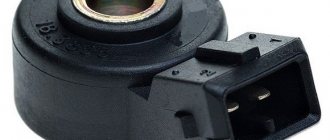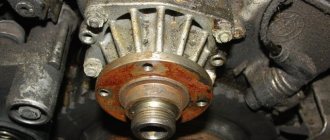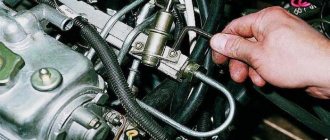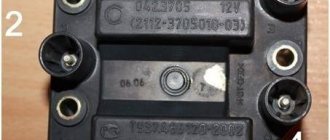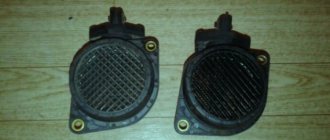› Logbook › Replacing the crankshaft damper pulley (torsional vibration damper)
It started with the fact that I couldn’t squeeze more than three thousand revolutions in any gear. The car started to jerk, I had to let go of the pedal and press less, the check came out, and the BC showed a DPV error. Because there was a bit of a strain on finances, I kept putting off the diagnosis. But then the apocalypse came and she finally didn’t give more than two thousand. Having spat on everything and reading everyone on the web, I came to the conclusion that it was most likely a damper.
Many motorists have encountered the fact that the VAZ-2114 crankshaft sensor stopped working. But, at the same time, not all motorists understood the signs of a malfunction until they contacted a car service center. So, in this article we will look at the reasons why a sensor failure can be determined, as well as how to diagnose it.
Crankshaft pulley VAZ 2114
Replacing the generator drive pulley on front-wheel drive VAZ and Lada cars
The generator drive pulley is changed in the same way on cars of the “tenth series” (VAZ 2110, 2111 and 2112), the “Samara” series (VAZ 2113, 2114 and 2115), as well as “new” Lada models Kalina, Priora and Granta.
The generator drive pulley is located on the “toe” of the engine crankshaft on the side of the first cylinder (right wheel) and drives the generator and, if equipped, air conditioning and power steering using a belt.
The main reasons for replacing a pulley are damage to the ring gear or delamination of the pulley itself.
Damage to the ring gear leads to unstable operation of the motor. If the teeth are broken, the car may not start because the crankshaft sensor (CSS) cannot determine the top dead center (TDC) for the ignition count.
Delamination occurs on damper pulleys (not cast iron). The fact is that on these pulleys the outer part is attached to the central part through a rubber spacer. It acts as a vibration damper (anti-resonance) on the engine crankshaft. It happens that the outer race rotates a little. Then the toothed pulley moves relative to the dead center and, as a result, the car becomes “sluggish” during acceleration, and the idle speed becomes unstable. If the pulley is too misaligned, the car cannot be started. Also, the car will not start with the upper race completely peeled off from the central part of the pulley.
Such damage is easily diagnosed by the lack of rotation of the alternator belt.
In rare cases, the seat key on the shaft breaks, and the pulley begins to vibrate and rotate. If the movements are small, then the ECU does not display an error on the instrument panel, but at the same time the engine at idle is unstable and “troits.”
Checking the condition of the pulley is quite easy. To do this, you need to inspect the condition of the ring gear for chips and cracks. The ring gear is located on the outer race closer to the engine (indicated by an arrow) and is clearly visible from above:
After this, you need to set the first cylinder to TDC. To do this, in an 8-valve engine, remove the rubber plug on the gearbox and ensure that the mark on the flywheel aligns with the slot on the plate:
You can check by the mark on the camshaft. To get to the mark, you need to unscrew the plastic protective cover. Fasten with three “10” bolts (two are shown in the photo, the bottom one under the hose from the end of the casing):
After unscrewing the casing, pull it up. There is a mark on the camshaft pulley (right arrow). We combine it with the protrusion of the metal plate (left arrow).
It is more convenient to turn the engine by placing the car in 4th or 5th gear and pushing in one direction. You can turn it using the bolt on the crankshaft pulley, but then you will have to remove the plastic mudguard behind the wheel.
In a 16-valve engine, it is necessary to remove the plastic protective timing cover. It is secured with 5 screws using a 5mm hex key. The article describes in detail the replacement of the phase sensor on Lada Kalina, Priora and Granta cars (16 valves).
Align the marks on the camshaft pulleys with the marks on the casing.
We make sure that the DKV looks at the beginning of the 20th tooth from the two missing ones. Often the teeth become misaligned due to the timing belt jumping. This can only be checked by aligning the marks on the flywheel with the marks on the camshaft or aligning the mark on the timing sprocket on the crankshaft (you will have to remove the pulley).
However, in a 16-valve engine, assessing the position of the mark through the box window is extremely inconvenient. It is much more convenient to unscrew the spark plug of the first cylinder and lower a depth gauge or a long screwdriver into the window. Using the depth gauge, set TDC (accuracy of about 10 degrees) and check the coincidence with the marks on the camshaft. If the marks coincide, and the DKV is not looking at the 20th tooth, then the problem is in the pulley. If not, then the belt has jumped or a key on the crankshaft has been cut off. In any case, the generator drive pulley must be removed to check or further align the timing belt.
So, we are convinced that the drive pulley needs to be removed for inspection.
To replace, we will need - from the main tool:
Chevrolet Niva crankshaft pulley price, which one to choose so as not to break?
I decided to install a new pulley again. I’ll try to stage it as taught... It wasn’t! But it’s alarming because the cause of the breakdown is not clear. I went to the store again. And lo and behold! That day there was a queue and for some reason all the buyers were purchasing parts for the Niva or Niva Chevrolet. While waiting in line, we started talking.
A man named Vlad (thank you very much, bro!) finally explained what the problem was. It turned out that Niva has two types of crankshaft pulley. The so-called damper:
Manufactured with a rubber damper inside. It is not visible until you press with your fingernail. In cars with high mileage, it even happens that when the damper wears out, the crankshaft begins to rotate the inner part, and the pulley breaks (the outer part of the damper pulley is hugged by the poly V-belt).
These are the pulleys that broke. And not only me... Vlad further explained that if you take another pulley (without a damper) the problem usually goes away. Such a damperless pulley for a Niva Chevrolet looks like this:
It weighs less and is solid. And one more amazing difference - such a damper-free Niva pulley costs only 900 rubles. And the damper weighted pulley (which I unsuccessfully bought to replace a broken one) costs 2800 rubles. How to continue to live


